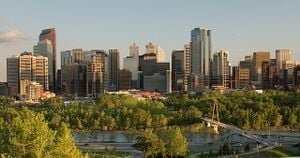
Networks and sustainability initiatives
Community involvement[edit | edit source]
- Abundant Community Edmonton, edmonton.ca, added 14:33, 18 May 2021 (UTC)
- Three Things (3thingsforcalgary.ca)
Community energy[edit | edit source]
Climate action[edit | edit source]
Edmonton Citizens' Panel on Energy & Climate[edit | edit source]
Starting in Oct 2012 a 56-member citizens' inquiry was commissioned by the city of Edmonton to help develop an energy transition plan.[1]
Open spaces[edit | edit source]
Community and voluntary action[edit | edit source]
- Volunteer Calgary, "strives to make Calgary a better place by helping nonprofit organizations build stronger relationships with individuals in their community."
Cycling activism[edit | edit source]
Bike Calgary is a member-based, non-profit organization based in Calgary, Alberta, Canada. With over 1,300 active members, it is the city’s largest advocacy group for utility cycling and active transportation.
Maps
Sustainable transport activism[edit | edit source]
Calgary Transit provides public transportation services throughout the city with regular bus service, bus rapid transit (BRT), and light rail transit (LRT). Calgary's light rail system, known as the CTrain, was one of the first such systems in North America (behind Edmonton LRT). It currently consists of two lines (Red Line and Blue Line), with 44 stations and 58.2 km (36.2 mi) of track. Most of the CTrain runs on both dedicated tracks with partial grade separation across suburban areas, and a street-level section across downtown. The CTrain is one of the continent's busiest, carrying 270,000 passengers per weekday and approximately half of Calgary downtown workers take the transit to work. The CTrain is also North America's first and only rapid transit system to run on 100% renewable, wind-generated energy. In early 2020, city council approved construction of the Green Line, the third light rail line in the city's rapid transit network. It will be the first rail line in Calgary to operate low-floor trains and is the largest public works project in the history of Calgary, about three-and-a-half times bigger than the second-largest project.
Spanning over 1,000 km (620 mi), Calgary has the most extensive walking and cycling pathway network in North America. There are also 290 km (180 mi) of on-street bikeways and 96 km (60 mi) of publicly maintained trails. As of 2017, 140,000 Calgarians cycle at least once a week and about 400,000 cycle occasionally. 40% of cyclists in Calgary ride no matter how cold it gets and 96% ride when temperatures are above 0 °C. The Peace Bridge provides pedestrians and cyclists access to the downtown core from the north side of the Bow River. The bridge ranked among the top 10 architectural projects in 2012 and among the top 10 public spaces of 2012.
In the 1960s, Calgary started to develop a series of pedestrian bridges connecting many downtown buildings.
Today, these bridges connect between most of the city's downtown office towers and make up the world's most extensive skyway network (elevated indoor pedestrian bridges), officially called the +15. The system shields pedestrians from the city's extremely cold winter temperatures. The name derives from the fact that the bridges are usually 4.6 m (15 ft) above ground.
News and comment[edit | edit source]
2015
Don't cheer Alberta's premier yet. Demand she break the oil barons' vice-grip, Martin Lukacs, November 24[2]
Another historic day in the battle to stop the tarsands, November 23[3]
Alberta's climate change strategy targets carbon, coal, emissions, November 23[4]
Calgary cycle track network: An overnight success story, 5 years in the making, November 4[5]
Energy democracy: building a solar dream in a tar sands nightmare, September 28[6]
About Alberta[edit | edit source]
Alberta is one of the thirteen provinces and territories of Canada. It is a part of Western Canada and is one of the three prairie provinces. Alberta borders British Columbia to the west, Saskatchewan to the east, the Northwest Territories to the north, and the U.S. state of Montana to the south. It is one of the only two landlocked provinces in Canada, with Saskatchewan being the other. The eastern part of the province is occupied by the Great Plains, while the western part borders the Rocky Mountains. The province has a predominantly continental climate but experiences quick temperature changes due to air aridity. Seasonal temperature swings are less pronounced in western Alberta due to occasional Chinook winds.
Alberta is the fourth-largest province by area at 661,848 square kilometres (255,541 square miles), and the fourth-most populous, being home to 4,262,635 people. Alberta's capital is Edmonton, while Calgary is its largest city. The two are Alberta's largest census metropolitan areas. More than half of Albertans live in either Edmonton or Calgary, which contributes to continuing the rivalry between the two cities. English is the official language of the province. In 2016, 76.0% of Albertans were anglophone, 1.8% were francophone and 22.2% were allophone.
External links
Wikipedia: Environmental impacts, Athabasca oil sands
References
- ↑ sharedfuturecic.org.uk, Oct 2019, p. 4
More here: participedia.net - ↑ The Guardian
- ↑ Greenpeace International
- ↑ CBC News
- ↑ calgarybuzz.com
- ↑ opendemocracy.net


